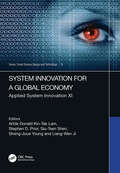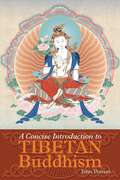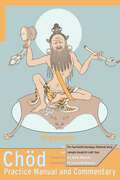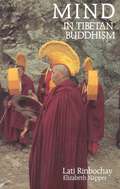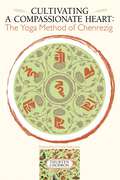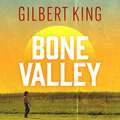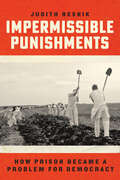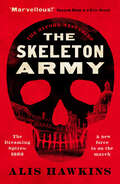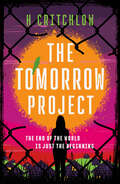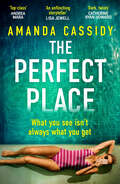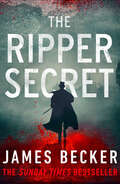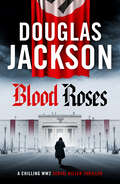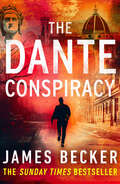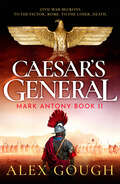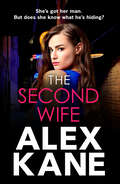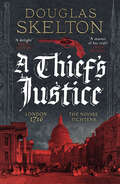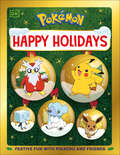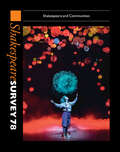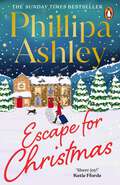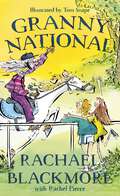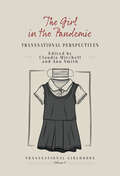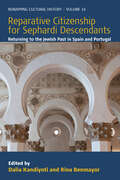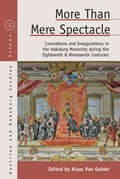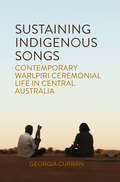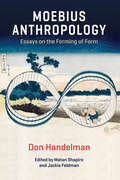- Table View
- List View
System Innovation for a Global Economy: Applied System Innovation XI (Smart Science, Design & Technology)
by Stephen D. Prior Siu-Tsen Shen Sheng-Joue Young Liang-Wen Ji Kin-Tak Lam, Artde DonaldSystem Innovation for a Global Economy contains the contribution to the 2025 International Conference on Applied System Innovation (ICASI 2025, Tokyo, Japan, April 22–25, 2025). Of the more than 500 submitted papers from 14 different countries, after review approximately a quarter was accepted for publication. The book aims to provide an integrated communication platform for researchers from a wide range of topics including information technology, communication science, applied mathematics, computer science, advanced material science, and engineering.System Innovation for a Global Economy enhances interdisciplinary collaborations between science and engineering technologists and is aimed at academics and technologists interested in the above-mentioned areas.
A Concise Introduction to Tibetan Buddhism
by John PowersLucid and economical, this introductory text delivers a brisk, fast-moving survey of Tibetan Buddhism. For many years Powers's nearly 600-page Introduction to Tibetan Buddhism has served as the field's most authoritative and comprehensive overview of Tibet's distinctive Buddhist tradition. A Concise Introduction to Tibetan Buddhism explains the core Buddhist doctrines and the practices of meditation and tantra and provides a survey of the four main schools of Tibetan Buddhism.
Chod Practice Manual and Commentary
by Jamgon Kongtrul Thekchok DorjeThis splendid resource for Chöd practitioners contains the Chöd sadhana written by the Fourteenth Karmapa. This daily practice text is given in three versions: Tibetan, a phonetic rendering of the Tibetan, and English translation. Jamgön Kongtrül's commentary on the sadhana supplies necessary amplification and clarification; it is given both in English and Tibetan. An important feature of the commentary is the inclusion of illustrations for the different stages of visualization discussed within the commentary. All in all, this is an essential practice tool and reference guide for the serious Chöd practitioner.
Mind in Tibetan Buddhism
by Elizabeth Napper Lati RinpocheIn the great Tibetan monasteries of Lhasa, monks seeking to purify their minds and develop the understanding necessary for final enlightenment began their inquiry into mind and consciousness by studying The Presentation of Awareness and Knowledge. Through understanding the nature of the mind and the process of cognition, inner peace can be attained. This text, plus Lati Rinbochay's rich and extensive commentary, give a comprehensive explanation of the nature and function of the mind, the different types of mind and mental factors, and how we develop knowledge and understanding. In her, introduction Elizabeth Napper gives an overview of the principal divisions of consciousness and mind.
Cultivating a Compassionate Heart: The Yoga Method of Chenrezig
by Thubten ChodronChenrezig (Avalokiteshvara / Kuan Yin) is not only Tibet’s patron deity, he also is the embodiment of the compassion of all the Buddhas and as such is deemed the best possible contemplative gateway to the cultivation of compassion. In this book, which has received high praise from monastics and lay Buddhist scholars alike, the American-born nun Ven. Thubten Chodron lucidly and engagingly elucidates the Tibetan Buddhist yoga of Chenrezig. Her explanations are based not only on scriptural but also oral teachings, which makes them eminently authoritative and practical. Essentially, Cultivating a Compassionate Heart is a knowledgeable, highly practical, and fairly extensive commentary on the Chenrezig sadhana. The book starts with the Thousand-Armed Chenrezig visualization and the preliminary prayers found in most sadhanas and the long mantra of Chenrezig. Only then does the author proceed to explaining the various concepts that make up the theoretical underpinnings of this extraordinary practice.
Bone Valley: Based on the internationally renowned true crime podcast
by Gilbert KingFrom Pulitzer Prize-winning author Gilbert King comes a chilling exploration of one of America's most haunting wrongful conviction cases. Based on the hit podcast, Bone Valley dives into the dark heart of rural Florida, where a young man's life was upended by a tragic miscarriage of justice.This program is read by the author and contains interviews (some previously unheard) and audio from the Bone Valley podcast by Lava for Good, plus a bonus conversation with Gilbert King and Leo Schofield.'Captivating, enraging, and all too true.' - Bob Kolker, New York Times bestselling author of Hidden Valley Road'Bone Valley is a work of rare moral clarity and deep compassion.' - Sister Helen Prejean, author of Dead Man WalkingIn 1988, Leo Schofield was arrested and charged with the murder of his wife, Michelle. Always insistent on his innocence, he was poorly served by his legal defense: the investigation was sloppy, the case flimsy and numerous pieces of evidence were ignored. He was sentenced to life in prison.Over thirty years later, Gilbert King is tipped off to Leo's case and is astonished by what he finds: layers of corruption, flawed evidence and deep-seated errors. He can't shake the story and starts to get to know Leo and his family. Leo shows an incomprehensible amount of grace and love about his situation, which spurs Gilbert even more to tell his story.Bone Valley is at once a revelatory investigation into a murder, a chilling portrait of the US criminal justice system and a uniquely powerful story of grace and redemption. Gilbert King has written a new classic of narrative nonfiction.P & C, Lava Productions, LLC 2022
Impermissible Punishments: How Prison Became a Problem for Democracy
by Judith ResnikAn original transatlantic history of the invention of the corrections profession and of ensuing debates about punishment’s purposes and prisoners’ rights. Impermissible Punishments explores the history of punishment inside prisons and how governments grappled with obligations to justify the punishments they impose. Legal scholar Judith Resnik charts the creation of the corrections profession and weaves together the stories of people who made rules for prisons and the stories of those living under the resulting regimes. Resnik maps three centuries of shifting ideas, norms, and legal standards aiming to draw lines between permissible and impermissible punishments. Her account documents the impact of World War II, the United Nations, the US Civil Rights movement, and the pioneering prisoners who insisted that law should protect their individual dignity. Taking us to the present, Resnik analyzes the expansion of imprisonment, the inability of public and private prisons to provide safe housing, and the impact of abolition politics. Exploring the interdependency of people in and out of prisons, Impermissible Punishments examines what governments committed to equality owe to the people they detain and argues that many contemporary forms of punishment need to end.
The Skeleton Army (Oxford Mysteries)
by Alis HawkinsWhy should the devil have all the best tunes?'Themes of inequality, forbidden love and personal responsibility weave through a fast-paced narrative in which the location plays a key part. Nation CymruThe Salvation Army has come prancing and singing from the slums of London to the poorest quarters of Oxford, but along with its red hot gospel preaching and music hall songs it brings a prohibition message which sparks immediate opposition and violence.An Army soldier an ex-drunk is brutally killed and a note suggests that the Salvation Army's shadowy enemy, the Skeleton Army, is responsible.With the police unwilling to come between the two forces, Non Vaughan, aspiring journalist and great hope of the Oxford women's college movement, and Basil Rice, Jesus College fellow and union-sanctioned guardian of the dead man's family, are compelled to investigate.But as the threats from both sides escalate, resulting in a second death, Non and Basil realise that they must stop the fighting before it results in an outright war. For with the University's annual commemoration week fast approaching, the entire city could be engulfed in fire and bloodAn utterly compelling historical mystery, and a fascinating portrait of Victorian Oxford, perfect for fans of Andrew Taylor, C. J. Sansom and Antonia Hodgson.
The Tomorrow Project: A powerful work of speculative fiction for fans of Station Eleven and The End We Start From.
by H CritchlowThe unmissable new speculative novel for fans of Station Eleven, The End We Start From and The Last of Us.When the end comes, what will you wish you had done?In 2050s London, fear grips like a vice as a deadly virus sweeps the globe. The British prime minister tells her people to remain calm. A vaccine will be available soon, and as a precautionary measure children will be whisked away to undisclosed locations, kept safe until the storm passes.Marianne, Downing Street press secretary, doesn't realise the futility until it is far, far too late. When the truth hits her, Marianne is forced to choose: stay with her family, or do whatever she can to help the doomed survive.As London falls, seven-year-old Maia is one of the last to escape the city. In an evacuation camp, she binds herself to Finn: in the absence of everything she knew, he becomes her everything.Yet as the years roll on and hope fades, Maia sees the bubble of safety is also a prison. She realises there is only one choice: to leave the camp and find what remains on the outside.An utterly compelling and unforgettable tale of humanity, resilience and the lengths we will go to for love. The Tomorrow Project is the stunning first novel from H Critchlow.Praise for The Tomorrow Project 'Powerful and disturbing' Harriet Tyce'Thrilling, heartbreaking, tense... I was immediately and incessantly caught up in it' James Delargy'Dark, vivid and beautifully written, The Tomorrow Project is a poignant, immersive novel about a future that spools out in terrifying clarity. It's also a novel about bravery and hope - and it will make you cry' Rachel Wolf'A fresh, original novel with characters who linger and a propulsive plot. I inhaled it in twenty-four hours. Genuinely unputdownable' Niki Mackay'Critchlow has the ability to observe humanity at its worst and heart-rending best. A worthy addition to the end-times dystopian canon' Jo Furniss'A heady mix of heartache and hope, love and loss, in a world that's splitting at the seams... I couldn't come up for air till I turned the last page' Robert Rutherford'A terrifying glimpse into a possible world' Sarah Moorhead'Masterful. A beautifully written parable of hope, love and humanity, it will live with me for a very long time' Rob Parker'A heartbreaking, vividly imagined tale of love and survival at the end of the world... a triumph of storytelling' Clare Leslie Hall'A deeply moving and beautifully written novel about loss and hope with a propulsive plot that will keep you turning the pages' Victoria Selman'A haunting and powerful read' Woman's Weekly
The Perfect Place: Escape to the Chateau meets The Paris Apartment in this twisty, unputdownable crime thriller
by Amanda CassidyImmersive story, sublime storytelling... top class' Andrea Mara, author of No One Saw a Thing What you see isn't always what you get.Elle Littlewood can barely believe her luck when her producer tells her about the chance to get her hands on a dilapidated chateau in Aix-En-Provence, France for a rock bottom price. It seems too good to be true, but as a home interiors influencer, she knows this would make incredible content.Lately, Elle has noticed the cracks start to show. Her life is the envy of thousands, and her social media posts show a beautiful, accomplished woman. Yet this wasn't always the case. If they knew the truth about her past, they would never look at Elle the same way again.Elle needs this house. She doesn't care that it comes with huge strings attached. And when people get in her way, there's nothing Elle won't do to protect her brand. After all, she's survived by doing things that people could never imagine and knows she would do them again.A dark, voyeuristic and utterly captivating crime thriller that fans of People Like Her and Sun Damage will love from CWA Debut Dagger shortlisted author Amanda Cassidy.Praise for The Perfect Place 'The perfect summer thriller' Matthew Blake, author of Anna O'A dark, twisty tale with a fascinating premise and unforgettable characters that grips and won't let go' Catherine Ryan Howard, author of The Trap'Propulsive plotting, beautiful prose, characters with heart... and the gorgeous backdrop of the south of France. The perfect read to slip into your suitcase this summer' Lizzy Barber, author of Out Of Her Depth'Addictive from the very first page until the very final twist... stays in your head long after the book is over' Joanna Dodd, author of The Summer Dare'Complex and gripping, with Cassidy's signature gift for character and location... The Perfect Place will keep you hooked to the twisty last page' Sam Blake, author of Three Little Birds'Unsettling and sinister... a perfectly paced psychological thriller that kept me guessing' Louisa Scarr, author of Gallows Wood'A captivating story, brilliantly told' Crime Scene'An enthralling read from an exciting writer' Prima'If you are a guilty fan of A Place in the Sun, this is the thriller for you' Daily Mail'Fantastic. I really enjoyed reading it' Reader review'SO good!!!! So intense and just kept me on my toes the whole time, I loved it!' Reader review'Amazing from start to finish. I forgot I was reading a book I just got so lost in the story' Reader review'I enjoyed this book filled with secrets, lies, deceit and murder!' Reader review'A perfect summer thriller. The twists are twisty! The entire book is engaging and fun to read' Reader review
The Ripper Secret
by James BeckerA priceless relic and a monster that will do anything to get hold of it.In the summer of 1888, a killer is about to rampage through East London. But what are the real motives behind the murders?Police Commissioner Charles Warren has in his possession an ancient artefact of incredible value, and unknowable danger. Discovered on a mission to Jerusalem, he smuggled the relic back to England, never imagining the peril he would place himself in, and more devastatingly, the women of Whitechapel.As the Ripper strikes, again and again, the truth may finally be uncoveredFans of Iain King, Scott Mariani and Boyd Morrison will love The Ripper Secret, a thriller that blows the legend of Jack the Ripper wide open.Praise for The Ripper Secret 'Interesting, original' Historical Novel Society
Blood Roses: Introducing 'the natural heir to Kerr's Bernie Gunther' (Warsaw Quartet)
by Douglas JacksonLonglisted for the 2025 CWA Historical Dagger'Jackson's hero is the natural heir to Bernie Gunther' Andrew Taylor, Sunday Times bestselling author of The Ashes of London'One of the UK's finest crime writers' Ben Kane, Sunday Times bestselling author of Napoleon's Spy'A remarkable crime debut' Maxim Jakubowksi, Crime TimeAs the Nazis roll into Warsaw, a serial killer is unleashedSeptember 1939. A city ruled by fear. A population brutalised by restrictions and reprisals. Amid the devastation, another hunter begins to prowl. What are a few more deaths amid scores of daily executions?Former chief investigator Jan Kalisz lives a dangerous double life, forced to work with the occupiers as he gathers information for the fledgling Polish resistance. Even his family cannot be told his true allegiance.When the niece of a Wehrmacht general is found terribly mutilated, Jan links the murder to other killings that are of less interest to his new overlords. Soon, he finds himself on the trail of a psychopathic killer known as The Artist. But, shunned as a Nazi collaborator, can he solve the case before another innocent girl is taken?A chilling serial killer investigation, perfect for fans of Simon Scarrow's Blackout and the TV series Hannibal starring Mads Mikkelson.Praise for Blood Roses 'A compelling, evocative story of evil stalking amidst the chaos of war' Giles Kristian'A dark, twisting thriller ... Jan Kalisz, Douglas Jackson's police officer hero, is the natural heir to the late Philip Kerr's Bernie Gunther' Andrew Taylor'A remarkable crime debut What raises the novel to another level is in the atmospheric evocation of a city in the process of being systematically obliterated by the Germans and brought to life again by Jackson's pen Gripping stuff, a series that could develop into something impressive and a goldmine for Philip Kerr Bernie Gunther fans' Maxim Jakubowski, Crime Time'Immensely powerful and vivid .... This is historical crime fiction at its best' Chris Lloyd'The writing is scalpel-sharp, the unrelenting savagery of the Nazi occupation vividly painted With this book, Jackson will rightfully be regarded as one of the UK's finest crime writers' Ben Kane'A taut, tense thriller Gutsy and gripping, this is perfect for fans of Chris Lloyd and Robert Harris' D. V. Bishop'Jackson has created a brilliant mash-up of WW2 thriller and a serial killer chiller, and in so doing brings a fresh perspective to both. Sharp, intelligent writing that makes for a compelling read' Alison Belsham'Jan Kalisz is a dazzling addition to the canon of compromised heroes... A thrilling wartime adventure story' Russ Thomas'Jackson brings the tension, brutality and paranoia of Warsaw of the period into murderous life. A knife-edge thriller' Douglas Skelton'A dark story set against dark times, you practically need a torch to read it' Alec Marsh, author of Rule Britannia'Jackson has written an utterly compelling novel ... A remarkable piece of work, a fine piece of craftsmanship' Scotsman
The Dante Conspiracy
by James BeckerAn ancient secret means the difference between life or death in this chilling thriller.When the body of a poetry professor is found tortured in a deserted barn outside Florence, Inspector Perini is assigned to the case.No murder of passion, it is clearly a professional job. When, hours later, thieves break into Dante's cenotaph, it seems the two crimes may be connected by some missing verses from the 'Divine Comedy'.They could contain a code so valuable someone is willing to murder for it. But who? And why? As the bodies pile up, Perini is in a deadly race to find the secret before the killers. The truth will prove more shocking than he could have possibly imaginedThe Dante Conspiracy is a chilling thriller perfect for fans of Dan Brown, Steve Berry and Alex Connor.Praise for The Dante Conspiracy 'An edge-of-the-seat thriller, with fantastic historical detail' Robert Foster, bestselling author of The Lunar Code
Caesar's General: An epic Roman adventure of civil war, love and loyalty (The Mark Antony Series)
by Alex GoughRome will never be the same againThe empire is at a crisis point. Caesar, Rome's greatest general and conqueror of Gaul, now faces being stripped of his command and dragged back to Italy for prosecution by his enemies.His former ally, Pompey, has sided with his opponents in the Senate and frustrates all efforts to find peace.Caesar does the unthinkable. He crosses the Rubicon and marches his army into Italy to invade Rome, with Mark Antony at his side. The empire is thrown into civil war. Antony will either rise to the heights of power, or be executed as a traitor. The die has been cast.This is the greatest story of Roman history retold from Mark Antony's perspective by a rising star of the genre. Perfect for fans of Conn Iggulden and Ben Kane.
The Second Wife: A pulse-pounding crime thriller that will keep you on the edge of your seat
by Alex KaneThis. Book. Is. Amazing...everything a psychological thriller should be, pure perfection! Nearly every chapter had my jaw dropping with another twist. Reader ReviewShes got her man. But does she know what hes hiding?Young, feisty, and beautiful, heads turn wherever Danica Campbell goes, even if she only has eyes for her fianc, Ricky Fyfe. He might be thirty years older than her, but his job as a big-time club owner in Glasgow means he can afford to give Danica the life she deserves.Danica knows he has a history after all, his adult daughter Teigan works at the club and she knows that Teigans mum, Elle, disappeared decades ago. It doesnt matter, because Danica knows that Ricky will do anything for her.Until the day that a woman walks into their lives and everything that Danica knew about Ricky falls to pieces. Faced with the reality of Rickys past, Danicas got some hard truths to swallow. But what Ricky doesnt know that Danica might just be keeping some secrets of her own and when he discovers them, their happy ever after might just come to a shocking endAn absolutely unputdownable Scottish crime thriller that fans of Lynda LaPlante and Kimberley Chambers will love.Praise for The Second Wife:'A phenomenal, brilliantly crafted belter of a read from start to finish, I couldnt turn the pages fast enough. A shining five stars!' A.A. Chaudhuri'Strong women, complex relationships and an ultra-twisty plot...A gripping page-turner, it will hook you from the start and leave you thirsting for revenge.' Heather Critchlow'A terrific read, and a whip smart narrative that holds you from page to page.' Anna SmithOMG! Just finished this fast-paced book and the tears are tripping me! I absolutely loved it and couldnt put it downright up there with Kimberley Chambers books! Highly recommend! Reader ReviewWow, this book packed a whole lot of punches the balance between a gripping thriller with the added dynamics of family, secrets and lies was fab. Reader ReviewBoom!!! What a book so many twists, chapter after chapterBrilliant, absolutely brilliant. Loved it. Reader ReviewAn addictive easy read with strong female leads throughout A twisty psychological thriller that grips you till its explosive ending. RECOMMENDED. Reader ReviewAbsolutely brilliant book, loved the storyline and the outcome. One of my favourite books of 2025. Reader Review
A Thief's Justice: A completely gripping historical mystery (Company of Rogues)
by Douglas SkeltonLondon, 1716. Revenge is a dish best served ice-cold'An immersive, action-packed thriller with intrigue in the air and threats around every corner' The Herald'Great fun ... the language is colourful and the action never stops' Laura Shepherd-RobinsonThe city is caught in the vice-like grip of a savage winter. Even the Thames has frozen over. But for Jonas Flynt thief, gambler, killer the chilling elements are the least of his worriesJustice Geoffrey Dumont has been found dead at the base of St Paul's cathedral, and a young male sex-worker, Sam Yates, has been taken into custody for the murder. Yates denies all charges, claiming he had received a message to meet the judge at the exact time of death.The young man is a friend of courtesan Belle St Clair, and she asks Flynt to investigate. As Sam endures the horrors of Newgate prison, they must do everything in their power to uncover the truth and save an innocent life, before the bodies begin to pile up.But time is running out. And the gallows are beckoning...A totally enrapturing portrayal of eighteenth-century London, and a rapier-like crime thriller, perfect for fans of Laura Shepherd-Robinson, Antonia Hodgson and Ambrose Parry.
Pokemon Happy Holidays
by DKCelebrate the festive season with Pokémon Happy Holidays – packed with cool facts and awesome activities, it’s the perfect present for the ho-ho-holidays!Discover the Pokémon who love a sparkly surprise, can rustle up a feast, or will make you shiver with their icy skills. Have fun spotting Squirtle in a snowball fight, or Pikachu in a cute woolly hat. Plus, you can test your Pokémon skills with cool quizzes, puzzles, and games. Pokémon Happy Holidays has everything you need to make the winter season even more merry!The perfect festive Pokémon book for young fans:Full of cute and colorful festive-themed Pokémon character art with easy-to-follow text for younger readers Loads of festive fun to keep readers coming back for moreIdeal for young Pokémon fans looking to celebrate the holiday season with some of their most-loved Pokémon friendsFull of Pokémon art, facts, and festive cheer, Pokémon Happy Holidays will keep young readers coming back year after year!
Shakespeare Survey 78: Shakespeare and Communities (Shakespeare Survey)
by Emma SmithShakespeare Survey is a yearbook of Shakespeare studies and production. Since 1948, Survey has published the best international scholarship in English and many of its essays have become classics of Shakespeare criticism. Each volume is devoted to a theme, or play, or group of plays; each also contains a section of reviews of that year's textual and critical studies and of the year's major British performances. The theme for Volume 78 is 'Shakespeare's Communities'. The complete set of Survey volumes is also available online at www.cambridge.org/core/publications/collections/cambridge-shakespeare. This searchable resource enables users to browse by author, essay and volume, search by play, theme and topic, and save and bookmark their results.
Escape for Christmas: The perfect festive holiday romance to curl up with this Christmas from the Sunday Times bestselling author
by Phillipa AshleySophie used to adore everything about Christmas. Hot chocolate and velvet bows, fairy lights and mince pies.Until the December her fiancé jilted her.Since then, Sophie opened Sunnyside Hotel, a quaint guesthouse nestled deep in the Cumbrian countryside.And, though it might be winter at Sunnyside, it’s never Christmas.Marketing her hotel to those who wish to avoid the festivities, Sophie is busy preparing for a season full of joy and laughter, but without the tinsel and mistletoe.Yet, as she finds herself growing closer to her gorgeous neighbour, Brody, her heart begins to melt.Will this Christmas bring the touch of magic Sophie needs to give love another chance?________________________Praise for Phillipa Ashley: ‘Sparkling and festive, as satisfying as figgy pudding and clotted cream – loved it!’ Milly Johnson‘Filled with warm and likeable characters. Great fun!’ Jill Mansell‘Warm and funny and feel-good. The best sort of holiday read’ Katie Fforde‘A delicious festive treat with as many twists and turns as a Cornish country lane’ Jules Wake‘A transporting festive romance, full of genuine warmth and quirky characters’ Woman’s Own‘Serious festive escapism . . . like a big warm hug’ Popsugar‘A page-turner of a festive read’ My Weekly‘Gloriously uplifting and unashamedly warm-hearted’ Faith Hogan‘A fantastic setting and intriguing premise, all bound together by Phillipa Ashley’s storytelling talent’ Sue Moorcroft'Picture perfect setting -tick!' Good HousekeepingSunday Times bestseller, November 2023
Granny National: A wildly fun horse-riding story for kids aged 8-10, written by the Grand National-winning Irish jockey
by Rachael BlackmoreTHE NO. 1 BESTSELLER'A rollicking read' Róisín Ingle, Irish Times---Rachael has had the best, most amazing, incredible idea! She’s determined to make her Granny’s lifelong dream of becoming a jockey come true … what could possibly go wrong?Easter holidays on the farm with Granny and Grandad are always great fun for Rachael, her cousin, Tom, and bestie Frankie. But this year, things are different – Rachael’s cousin David is visiting from New York! What will he be like? Will he like the farm, the ponies Bubbles and G-Pip, or will he ruin all the fun?When Rachael's brilliant idea strikes, the gang must come together for Operation Granny National. They set out to help Granny live her dream of becoming a jockey. But will they pull it off? And what happens when everyone finds out what they’ve done? There’s bound to be BIG trouble ahead!
The Girl in the Pandemic: Transnational Perspectives (Transnational Girlhoods #5)
by Claudia Mitchell and Ann SmithAs seen in previous pandemics, girls and young women are particularly vulnerable as social issues such as homelessness, mental healthcare, access to education, and child labor are often exacerbated. The Girl in the Pandemic considers what academics, community activists, and those working in local, national, and global NGOs are learning about the lives of girls and young women during pandemics. Drawing from a range of responses during the pandemic including first person narratives, community ethnographies, and participatory action research, this collection offers a picture of how the COVID-19 pandemic played out in eight different countries.
Reparative Citizenship for Sephardi Descendants: Returning to the Jewish Past in Spain and Portugal (Remapping Cultural History)
by Dalia Kandiyoti and Rina BenmayorIn 2015, both Portugal and Spain passed laws enabling descendants of Sephardi Jews to obtain citizenship, an historic offer of reconciliation for Jews who were forced to undergo conversions or expelled from Iberia nearly half a millennia ago. Drawing on the memory of the expulsion from Sepharad, the scholarly and personal essays in Reparative Citizenship for Sephardi Descendants analyze the impact of reconciliation laws on descendants and contemporary forms of citizenship.
More than Mere Spectacle: Coronations and Inaugurations in the Habsburg Monarchy during the Eighteenth and Nineteenth Centuries (Austrian and Habsburg Studies)
by Klaas Van GelderAcross the medieval and early modern eras, new rulers were celebrated with increasingly elaborate coronations and inaugurations that symbolically conferred legitimacy and political power upon them. Many historians have considered rituals like these as irrelevant to understanding modern governance—an idea that this volume challenges through illuminating case studies focused on the eighteenth- and nineteenth-century Habsburg lands. Taking the formal elasticity of these events as the key to their lasting relevance, the contributors explore important questions around their political, legal, social, and cultural significance and their curious persistence as a historical phenomenon over time.
Sustaining Indigenous Songs: Contemporary Warlpiri Ceremonial Life in Central Australia
by Georgia CurranAs an ethnography of Central Australian singing traditions and ceremonial contexts, this book asks questions about the vitality of the cultural knowledge and practices highly valued by Warlpiri people and fundamental to their cultural heritage. Set against a discussion of the contemporary vitality of Aboriginal musical traditions in Australia and embedded in the historical background of this region, the book lays out the features of Warlpiri songs and ceremonies, and centers on a focal case study of the Warlpiri Kurdiji ceremony to illustrate the modes in which core cultural themes are being passed on through song to future generations.
Moebius Anthropology: Essays on the Forming of Form
by Don HandelmanDon Handelman’s groundbreaking work in anthropology is showcased in this collection of his most powerful essays, edited by Matan Shapiro and Jackie Feldman. The book looks at the intellectual and spiritual roots of Handelman’s initiation into anthropology; his work on ritual and on “bureaucratic logic”; analyses of cosmology; and innovative essays on Anthropology and Deleuzian thinking. Handelman reconsiders his theory of the forming of form and how this relates to a new theory of the dynamics of time. This will be the definitive collection of articles by one of the most important anthropologists of the late 20th Century.
